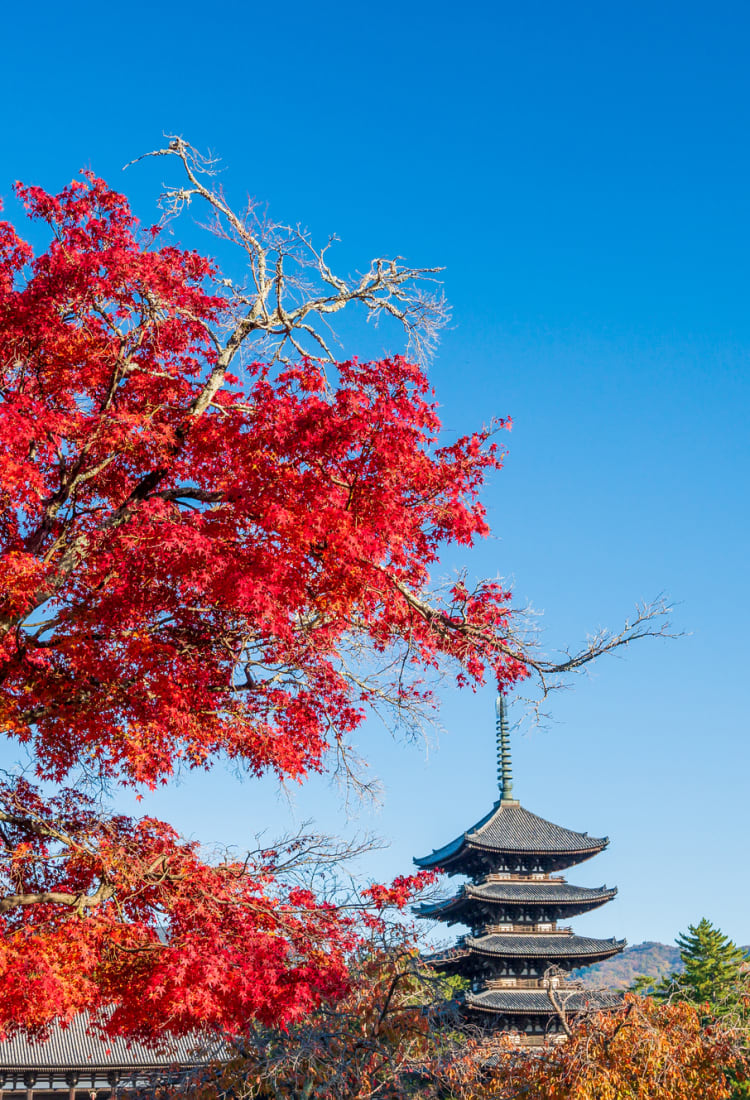
2020.11 Discover the Autumn Landscapes of Japan’s Ancient Cities Through Virtual Tours
Start planning your next trip to Japan with a virtual tour
Welcome to Nara—Japan’s ancient capital city and a World Heritage Site

Nara’s temples and shrines are set in beautiful countryside.
Nara is a 35-minute train ride from Kyoto. The area was instrumental in Japan’s beginnings and was the center of Buddhism when the religion arrived in Japan from the Asian continent during the sixth century. In 710, Heijo-kyo (present-day Nara City) became Japan’s first fully-fledged capital city, and the area prospered as the cultural and religious center of Japan. In 1998, a selection of Nara’s temples and shrines, along with the remains of the great Imperial Palace, were granted UNESCO World Heritage status under the collective banner “Historic Monuments of Ancient Nara.”
Explore Nara’s World Heritage Sites virtually to a backdrop of autumn foliage
Three of Nara’s most prominent World Heritage sites are Kofukuji Temple, Todaiji Temple, and Kasuga Taisha Shrine. You can explore each of these sites from the comfort of your home through virtual tours with Japan Wonder Travel. Each site has their own particular points of interest. Here are some of the highlights of a virtual tour.
The five-story pagoda is a centerpiece of the grounds of Kofukuji Temple. The pagoda, at around 50 meters (164 ft.) high, is the second tallest wooden pagoda in Japan. The structure, originally built over 1,300 years ago, was inspired by similar Buddhist structures on the Asian continent and is testament to the architectural capabilities of the times. Kofukuji Temple hosts rare Buddhist statues, such as the Ashura sculpture, which was designated a National Treasure by the Japanese government.
The original five-story pagoda was built in 730, but it was destroyed multiple times by fires. The one standing today is a faithful reconstruction.
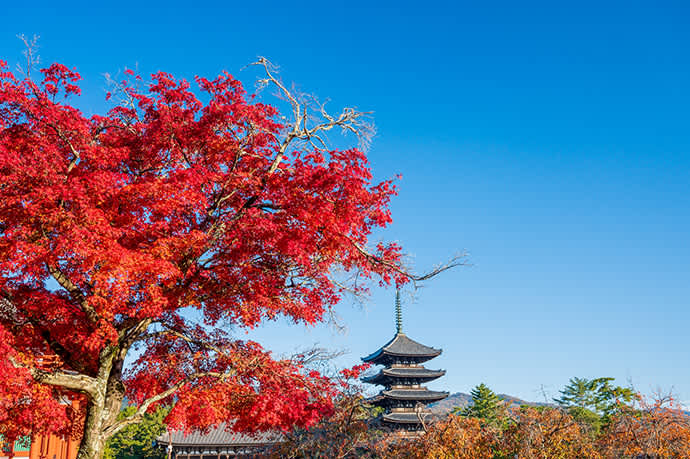
The five-story pagoda and autumn leaves at Kofukuji Temple.
Inside the Daibutsuden (Great Buddha Hall) of Todaiji Temple is a large statue of Buddha. The statue stands approximately 15 meters (49 ft.) tall and symbolizes the central role Buddhism plays in Japanese society.
Compared to the understated brown tones of Todaiji Temple, the bright vermillion main building of Kasuga Taisha Shrine gives visitors a sense of the glamorous culture of the Nara-period (710-794) aristocracy. There are thousands of ornate lanterns around the shrine building.

The vermillion-red main shrine building at Kasuga Taisha.
Explore Nara on a guided virtual tour
One benefit of a virtual tour is the opportunity to become familiar with a place before arriving in person. Guides from Japan Wonder Travel’s virtual tour, “Enjoy Japanese Ancient City (Nara) with Friendly Deer,” will introduce Nara’s main attractions, including the World Heritage Sites listed above, in a 45–60 minute interactive tour conducted in English.

Learn about one of the symbols of Nara: deer. Photo credit: Japan Wonder Travel/※PhotoAC
The tour begins with self-introductions and each participant shares their reasons for joining the tour. The guide will then customize the tour based on the group’s areas of interest and amount of prior knowledge. Deer and Buddhist statutes have been popular topics in past tours, and the guides are fully prepared to introduce these topics.

Your guide can inform you about the history of the large Buddha statue at Todaiji Temple.
Joining the virtual tour also gives you the chance to experience the Shinto ritual of the Lantern Festival at Kasuga Taisha Shrine from your own home. During the ritual, priests light all 3,000 lanterns on the shrine grounds. The event is only held three times a year, but it can be viewed on demand online.

The lanterns at Kasuga Taisha Shrine. Watch the lamp-lighting ritual online.
The company began offering virtual tours in summer 2020 and many virtual visitors from around the world have already participated. Many of those who joined the tours spoke of finding positivity during the COVID-19 pandemic through the tour experience and the opportunity to plan future travel. Other participants mentioned they enjoyed getting to know others with similar interests. Virtual tours through Japan Wonder Travel can be given as gifts—the perfect present for family and friends who like Japan.

Ms. Tsujimoto is a guide with Japan Wonder Travel. Photo credit: Japan Wonder Travel
The tour company organizes in-person tours as well as virtual ones. Travelers in Japan can take a tour of Nara on the “Nara World Heritage Private Walking Tour from Kyoto.” Japan Wonder Travel guides accompany travelers through Nara Park where they can encounter the park’s famous residents—the deer. Those joining the tour can learn about Nara’s history and culture while exploring the area with an English-speaking guide. Since the tour is private, you can tell the guide where you would like to visit. If visiting in the autumn, ask about lesser-known places to view the fall foliage.
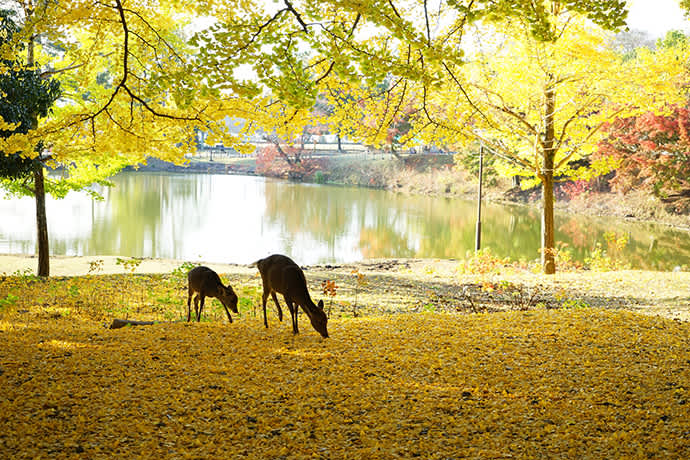
Deer among the autumn leaves in Nara Park.
Nara’s green leaves of summer turn to vibrant shades of red and gold from around mid-November to early December. Popular spots to enjoy the autumn views include Tanzan-jinja Shrine and Hasedera Temple; both around an hour’s drive from central Nara. However, guide Yoshiko Tsujimoto from Japan Wonder Travel offers visitors insider information on some beautiful spots in the heart of the city. She recommends the autumn leaves of the ginkgo trees behind the Great Buddha Hall at Todaiji Temple and the maple trees at Tamukeyama Hachimagu Shrine next door. If joining a tour, ask your guide to take you to local places that have fewer crowds.
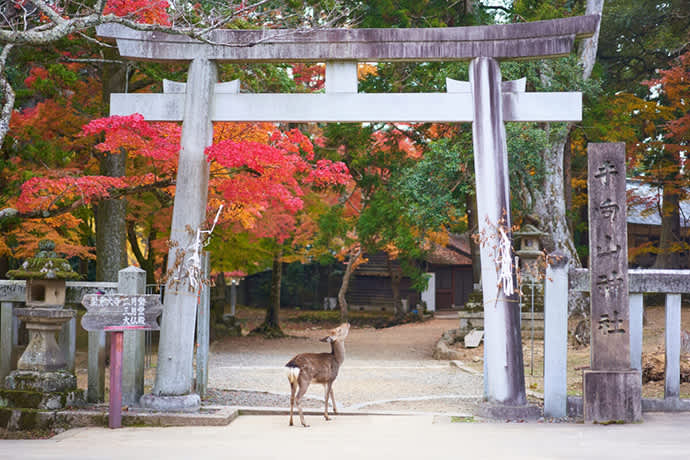
A deer in front of Tamukeyama Hachimagu Shrine. Photo credit: Japan Wonder Travel/※Unsplash@Timo Volz
Welcome to Hida-Takayama—a city frozen in time, deep in the Gifu mountains

Hida-Takayama flourished as a merchant town in the Edo period (1603-1867) and elements of the original townscape remain. Photo credit: JAPONISME
The atmospheric city of Hida-Takayama is located deep in the mountains of northern Gifu Prefecture. The densely forested area is approximately four hours from Tokyo by a combination of bullet train and limited express train. The relative inaccessibility has helped the town retain its the Edo-period (1603-1867) streetscapes. The stretches of traditional wooden houses take visitors back to a time where samurai would roam the mountainous landscape. Hida-Takayama might resemble olden-day Japan, but modern conveniences such as Wi-Fi help to create an easier travel experience. Pamphlets and maps in multiple languages are on offer to support non-Japanese-speaking visitors.
JAPONISME runs both virtual and in-person tours of Hida-Takayama. Your guide will introduce you to the history and culture of the area, including the spectacular Takayama Festival, the Kusakabe Folk Museum, and the traditional streetscapes.
Feel the energy of Hida-Takayama’s culture and autumn festivals
Hida-Takayama has a long history of carpentry and woodworking. In the past, Hida’s artisans went to Heijo-kyo in Nara and contributed their skills to build temples and shrines including Todaiji Temple. Hida-Takayama’s woodworking legacy remains, and visitors on in-person tours can see the outstanding carpentry skills of local artisans on the floats of the Takayama Festival, at Takayama Jinya—the only provincial governor/magistrate’s office from the Edo period that exists in Japan—and the Kusakabe Folk Museum, which recreates a merchant home in the Edo period.

The interior of the Kusakabe Folk Museum crafted by Hida’s skilled woodworkers. Photo credit: JAPONISME
The Takayama Festival is the highlight of the Hida-Takayama festival calendar. During the event, a parade of splendid floats called “yatai” are pulled through the streets. Floats are decorated with mechanical puppets, gold ornaments, and carvings by the skilled artisans of Hida. The festival takes place twice a year, in spring and autumn. The autumn festival is held on October 9 and 10 every year, around the time the mountain foliage begins to change color. The festival has been designated an Intangible Cultural Heritage by UNESCO.

Takayama Festival floats are adorned with many paper lanterns.
Travelers visiting Hida-Takayama in person can join a tour with the local tour company, JAPONISME. Your guide to the area is Mika Shiraishi, a nationally licensed tour guide with extensive knowledge of Japanese culture and traditions. Her experience living in the area means she has plenty of insider information to share with tour participants.

Mika has led over 2,000 people on guided tours. Photo credit: JAPONISME
The tour is private, so you can customize it according to your needs. Tour participants are free to make requests that match their interests, such as a longer time spent strolling along old streetscapes, visiting a historical sake brewery to learn about sake or a morning market to buy local products, and viewing the area’s traditional thatched-roof buildings.
Discover Hida-Takayama through video on a virtual tour
JAPONISME guide Mika hosts “Virtual Tour Japan -Takayama-.” She filmed her original point-of-view videos by walking through the streets of Hida-Takayama and hopes that through these images, she can offer virtual travelers from around the world the next-best thing to an in-person tour. Mika’s aim is to convey the beauty and traditions of the area.
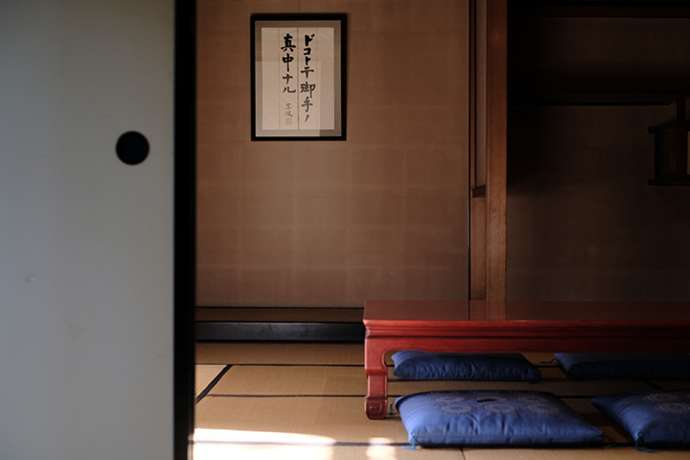
The virtual tour takes online visitors inside the Kusakabe Folk Museum that features architectural techniques from the Edo period. Photo credit: JAPONISME
The 75-minute tour introduces visitors to the area’s old streetscapes, the spectacular Takayama Festival, and the Kusakabe Folk Museum, along with detailed explanations on Japanese tradition and culture. Mika discusses diverse topics such as the difference between Shinto and Buddhism, the Edo period's class system, and the meaning of “sugidama” (balls made of Japanese cedar sprigs) placed at the entrance of sake breweries. Mika wants her virtual tours to be entertaining. She makes sure online participants have a good time by weaving quizzes and humor into her tour.

Mika holds interactive tours and answers questions from participants at any point in the tour. Photo credit: JAPONISME
Mika strongly believes that visitors equipped with knowledge will look at the surrounding scenery differently and gain a more profound travel experience. She says, “I hope people become more familiar with Hida-Takayama through virtual exploration and then visit the area in-person with a guide.”

Hida-Takayama in the autumn.
Information
Japan Wonder TravelJapan Wonder Travel offers virtual tours and in-person tours for foreign visitors to Japan. The in-person tour, “Nara World Heritage Private Walking Tour from Kyoto,” is an eight-hour private tour around the Nara area traveling on foot and by train. “Enjoy Japanese Ancient City (Nara) with Friendly Deer” is a virtual group tour that requires 45–60 min. Online reservations can be made from the website. |
JAPONISMEThis tour company based in the city of Takayama, Gifu Prefecture offers both virtual and in-person tours in English. In-person tours are private and can be reserved for either 1 day (6 hr.) or half a day (3 hr.). “Virtual Tour Japan -Takayama-” is a virtual group tour that requires 75 min. Online reservations can be made from the website. |
Kofukuji Temple |
Todaiji Temple |
Kasuga Taisha Shrine |
Nara Park |
Hasedera Temple |
Tanzan-jinja Shrine |
Tamukeyama Hachimangu Shrine |
|
WEB:- |
Takayama Jinya |
Kusakabe Folk Museum |
Related Links
Official Nara Travel Guide |
HIDA TAKAYAMA Tourist Information |




















































